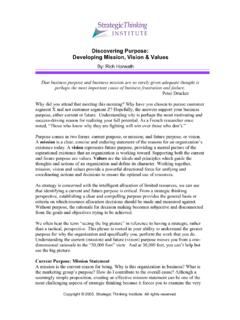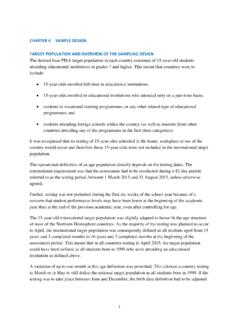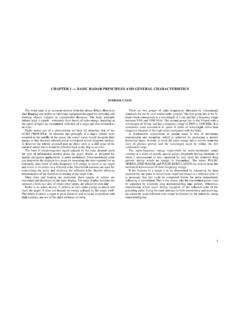Transcription of Target Markets: Segmentation & Evaluation
1 CHAPTER 5. Target Markets: Segmentation & Evaluation Devy Schonfeld Housekeeping Turn off your cell phones an put them away. Put your Name Cards out. Look at Assignment 1; I will review it in class on Thursday. Due in class on March 10th We will have a quiz on March 8th. Covers Chapters 3 and 4. There is no make-up for quizzes. Arturo Litwak will be here on March 10th. Exam 1 is March 22nd. It will cover Chapters 1-8 (incl). Open book; no technology;. will not cover my notes. You will need a #2 Pencil and a Scantron There is no make-up for exams! Discuss the term market from a marketing Learning perspective.
2 Objectives Explain the importance of Segmentation and targeting. Apply the major Segmentation variables. Investigate the importance of sizing a Target market. What will you Conduct basic Segmentation analysis. be able to do Develop a marketing mix for a particular segment. after this class? Markets Defined A market is a group of people, individuals or organizations that have: Desire or needs for products in a product class Ability, willingness, and authority to purchase such products There are Two Categories Consumer market: Purchasers and household members who intend to consume or benefit from the purchased products and do not buy products to make profits.
3 Typically called B2C. Business market: Purchase a specific kind of product for resale, direct use in producing other products and use in general daily operations. We will discuss B2B markets in another class. What type of market do you serve? Homogenous: Large proportion of customers have similar needs for a product Examples: salt, sugar, milk, gas, Heterogeneous: Customers have diverse needs for products in a specific product class Computers -laptops vs desktops; Macs vs. PCs, Books fiction, non-fiction, e-Readers Market Segmentation is A market the process of segment is a dividing a market group that has into a group that similar needs have similar needs How Do You Segment a Market?
4 How do you break apart a large group to identify a group that you are interested in? Target Marketing Process: Linking Customer Needs to Marketing Action Objective of Market Segmentation It is your goal to: Identify segments that have the greatest profit potential based on their requirements and your capabilities Market Segments Breakfast Cereal Market Segments 1. Identify the appropriate targeting Target Market strategy Selection 2. Determine which Segmentation Process variables to use 3. Develop Market Segmentation Profiles 4. Evaluate relevant market segments 5. Select Specific Target Markets Step 1: Target market Consumers for whom a business creates and Identify the maintains a marketing mix appropriate Assignment 1.
5 Strategy selection for Target market targeting is affected by: strategy Target market characteristics Product attributes Organization's objectives and resources What is an Undifferentiated Strategy (eggs, salt, milk). example of each one Concentrated of these Strategy (Rolex, Harley Davidson, Tesla, Forever 21 . targeting maybe; typically used for small segments). strategies? Differentiated Strategy (Holiday Inn . Express, Crowne Plaza, Resort, Vacation, Intercontinental; McDonalds;. Disneyland; Economist Magazine). Holiday Inn's Differentiated Strategy Which bucket do these products/brands Fit in?
6 UNDIFFERENTIATED CONCENTRATED DIFFERENTIATED. Community College Education Customer's needs must be heterogeneous Conditions for Segments must be identifiable and divisible Market Marketer must be able to compare the Segmentation different market segments to succeed In terms of sales potential, costs, and profits One segment must have enough profit potential to justify developing a special marketing mix Company must be able to reach the chosen segment with a particular marketing mix What variables do you use to segment? What is a Segmentation Variable?: characteristics of individuals, groups or organizations used to divide a market into segments Should relate to the customers' needs for, uses of or behavior toward the product Must be measurable Company resources and capabilities affect the number and size of the variables Product type and degree variations in customer needs The following variables are most often used to segment markets Ethnicity vs.
7 Race? Climate and terrain Geographic Variable City size and population density Urban area and rural area Market density: Number of potential customers within a unit of land area Useful Segmentation variable for firms because low- density markets require different sales, advertising, and distribution activities than high-density markets Geographic Variable Climate affects numerous markets. Customers' needs for automotive accessories, such as tires, vary based on climate. Personality characteristics Psychographic Motives - Divides the market according to Variables consumers' reasons for making a purchase Lifestyle analysis - characteristics related to people's activities, interests, and opinions Lifestyle Segmentation groups people by: Demographics explain who your Target is, How they spend their time psychographics The importance of things in their surroundings explain WHY they buy!
8 Beliefs about themselves and broad issues Psychographic Variables Which bucket do these products/brands Fit in? DEMOGRAPHIC GEOGRAPHIC PSYCHOGRAPHIC BEHAVIORISTIC. 1. Identify the appropriate targeting Target Market strategy Selection 2. Determine which Segmentation Process variables to use 3. Develop Market Segmentation Profiles 4. Evaluate relevant market segments 5. Select Specific Target Markets Segmentation Profile Development Fitness Chain Segmentation Profile: profiles/segment-profile-example/. Step 4 - Evaluate Relevant Market Segments Market Segment Aspects to be Evaluated Sales Estimated Competition Estimates Costs Market How big is the overall market?
9 Potential Remember the market sizing activity you did in the Target Market homework? Stated in terms of dollars and units How much of that market share is it Entrepreneurship Tip! realistic for your to capture? If you are thinking of starting your own Can you impact that by adjusting your Segmentation or marketing mix? business, then think about capturing a share What are your organization's resources? of a small market not a What are the environmental factors? big one! Evaluating the Market m/understanding- Target - markets/evaluating-potential- Target - markets/. Create a Profile for Hiking Club at LAMC.
10 What characteristics would you look for to segment the market and develop your Target market? Demographic Geographic Psychographic Behavioristic Hands on Exercise: Segment a market, What is your marketing mix? create a Target market Product and develop a Price Product/Service! Promotion Place/Distribution Create a Profile for Hiking Club at LAMC. Segmentation Variables: Marketing Mix: 1. Demographic 1. Product 2. Psychographic 2. Price 3. Geographic 3. Promotion 4. Behavioral 4. Place/Distribution How Do You Know Whom to Market To? 1. What needs do your product/service address? 2. Who values the key attributes of your product 3.

















